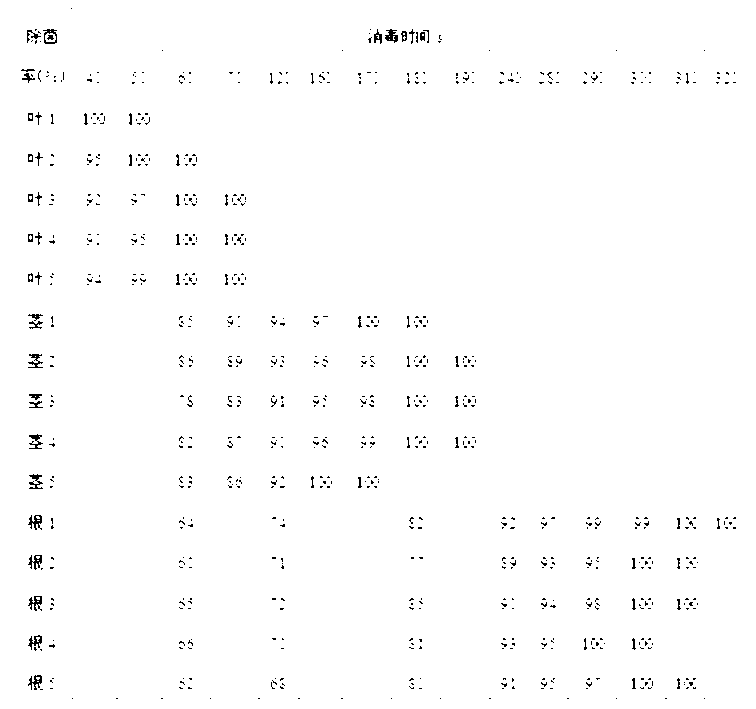Separation method for plant endophyte
A technology for plant endophytes and isolation methods, which is applied in the field of separation of plant endophytes, can solve the problems of insufficient representation of quantity and species, uneven distribution of endophytes, limited number and types of endophytes, etc., to achieve The effect of ensuring accuracy and improving work efficiency
- Summary
- Abstract
- Description
- Claims
- Application Information
AI Technical Summary
Problems solved by technology
Method used
Image
Examples
Embodiment 1
[0031] —— Surface disinfection experiment of various plant tissues
[0032] Experimental materials and methods: The roots, stems and leaves of K326 tobacco were used as experimental materials, and healthy plants with good growth characteristics and no disease symptoms were selected for sampling. The root, stem, and leaf samples of K326 tobacco were separated from the plants, rinsed, numbered 1, 2, 3, 4, and 5, respectively, and packed in sealed bags, and kept fresh at 4°C for later use.
[0033] Randomly weigh 0.4 g of the cleaned root, stem and leaf samples of each tobacco, first shake and soak in 70% ethanol solution for 60 seconds, then shake and soak in sodium hypochlorite solution with 1% available chlorine content for 40~320 seconds, and then use non- Rinse with bacterial water 4 times. Coat the NA plate with the last rinse water, record the number of colonies after incubating at 28°C for 48 hours, calculate the surface sterilization rate to test the sterilization effe...
Embodiment 2
[0041] —— Isolation of Tobacco Endophytes
[0042] Experimental materials and methods: The roots, stems and leaves of K326 tobacco were used as experimental materials, and healthy plants with good growth characteristics and no disease symptoms were selected for sampling. The root, stem, and leaf samples of K326 tobacco were separated from the plant, rinsed, packed in sealed bags, and kept fresh at 4°C for later use.
[0043]Randomly weigh 0.4g of the cleaned tobacco roots, stems, and leaves, first shake and soak in 70% ethanol solution for 60s, then shake and soak the roots, stems, and leaves in sodium hypochlorite solution with 1% available chlorine 60s, 180s, 300s, then rinse with sterile water 4 times. Coat the NA plate with the last rinse water and incubate it at 28°C for 48 hours as a control for surface disinfection. If no colonies are formed on the control plate, it proves that the surface is fully disinfected, and all the isolates obtained in the subsequent steps are...
Embodiment 3
[0046] —— Isolation of Tobacco Endophytes
[0047] It is basically the same as Example 2, except that: the root, stem, and leaf of Yunyan 85 tobacco are used as experimental materials; the root, stem, and leaf samples of tobacco are soaked in a sodium hypochlorite solution with an available chlorine content of 1% for 40s, 170s, and 40s respectively. 310s; the grinding time is 240s, the frequency is 20r / s; the sizes of the sterilized steel balls are 3mm and 1mm respectively.
PUM
 Login to View More
Login to View More Abstract
Description
Claims
Application Information
 Login to View More
Login to View More - R&D
- Intellectual Property
- Life Sciences
- Materials
- Tech Scout
- Unparalleled Data Quality
- Higher Quality Content
- 60% Fewer Hallucinations
Browse by: Latest US Patents, China's latest patents, Technical Efficacy Thesaurus, Application Domain, Technology Topic, Popular Technical Reports.
© 2025 PatSnap. All rights reserved.Legal|Privacy policy|Modern Slavery Act Transparency Statement|Sitemap|About US| Contact US: help@patsnap.com


